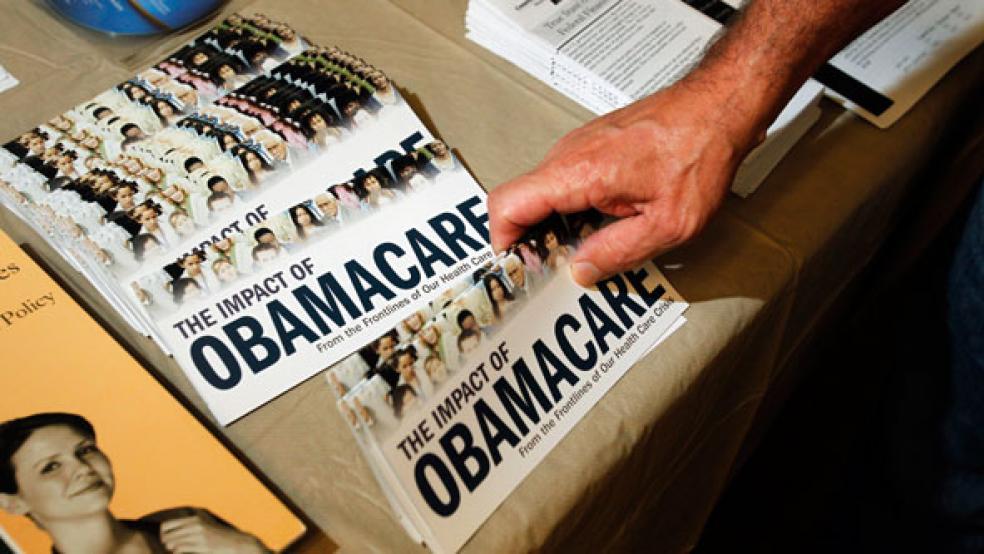The White House is doing a victory lap as the Affordable Care Act’s first open enrollment period has come to a close.
As of midnight last night, the administration had reportedly reached its original goal of enrolling some 7 million people on the new exchanges—a feat that seemed nearly impossible at the beginning of March when enrollment was at 5 million.
Related: Obamacare Support and Sign Ups Surge On Deadline
Though this is certainly good news for the White House, there are still hurdles ahead of the law and many crucial questions we need to answer before we can fully assess how it’s really shaping up.
Here are five things to watch:
1. What is the impact on the uninsured population?
The key goal of the president’s health care law is to expand access to coverage to the 37 million eligible uninsured Americans.
The administration has not yet tracked how many of the 7 million people who have enrolled in the exchanges were previously uninsured. This will be crucial to understanding how well the law is performing. An independent study by the Rand Corporation estimates about one-third of people or a little over 2 million people signing up through the exchanges were previously without coverage.
Several polls, including Gallup, show the uninsured rate is at its lowest level in recent history. Though experts suggest the ACA could be playing a role in the decline, as well as the unemployment rate, it is still too early to know.
Separately, at least 4.5 million people have gained coverage through Medicaid expansion, and an additional 3 million young adults are now staying on their parents’ policies under the law, as noted by The Los Angeles Times.
2. How many people have paid their first premiums?
The number of enrollments on the state and federal exchanges has served as a go-to measure of the law’s success. So far, the White House estimates that it has met its original goal of enrolling about 7 million people on the exchanges. However, that number could climb, since those who struggled with website issues are still allowed to enroll beyond the deadline.
Still, it’s important to note that this figure does not represent how many people have actually paid for their policies. Health and Human Services Secretary Kathleen Sebelius cited insurers' estimates in an interview Monday that about 80 to 90 percent of enrollees had paid. This means about 10 to 20 percent of the administration’s enrollment numbers will not actually be gaining coverage under the exchanges.
3. What is the mix of enrollees?
It’s not all about the numbers, it’s about who is behind the numbers.
The administration has stressed the importance of enrolling enough young and healthy people to offset the cost of premiums for older, sicker Americans. Originally the White House wanted people between the ages of 18 to 34 to make up about 40 percent of total enrollment.
The latest estimates suggest the national breakdown is somewhere around 25 percent. However, the state figures matter more than the national figures—especially when it comes to the price of premiums, since insurance markets are state-based. While, the District of Columbia, Utah, Kansas, Louisiana and South Dakota all enrolled a high number of young people, Oregon, Hawaii and Arizona failed to sign up the younger demographic.
Beyond age, it will also be important to know more about the demographic breakdown of enrollees. Early on in the rollout, the Spanish-language version of the website CuidadodeSalud.gov , suffered severe technical glitches and was delayed, causing Latino enrollments to lag behind. Similarly, a coalition of Asian American community groups sent a letter to HHS, saying the website had confusing translation issues.
4. What will premium and deductible prices be like next year?
Insurers are analyzing their mix of enrollments as well as costs for this year, which will help them set rates for next year. The rates will depend on who has enrolled as well as where the markets are. Insurers also say a combination of Obamacare’s new taxes and fees as well as rule changes and delays will likely contribute to higher than expected rates. Several insurers have already warned that they expect rates to increase significantly—in some parts of the country, the rates are expected to triple. Others say rates will hold steady, as their mix of enrollees is more robust.
Insurers will be submitting their rates to state regulators by the end of May. However, they won’t be publically released until next fall ahead of open enrollment in November.
5. What is the impact on the political landscape?
Obamacare is shaping up to be the most divisive issue in the coming midterm elections, so it will be important to see how the law’s rollout has impacted voters. While Democrats are pointing to the millions of people who have gained coverage under the new law, Republicans are focusing on the price of premiums and deductibles, which is likely to increase next year. Right now, voters seem to be largely split over the health care law. A new Washington Post poll released Monday showed that for the first time ever more people support, rather than oppose Obamacare. Though the findings are not divisive—49 percent support the law, 48 oppose it-- they are significant ahead of the elections.
The rising support of the law, as well as the increasing number of sign ups, is good news for congressional Democrats—especially in the Upper Chamber, where Democrats are vulnerable of losing the Senate. Still, Republicans are vowing to continue working to dismantle the healthcare law, which they claim is both a debt driver and a job killer. “The president’s health care law continues to wreak havoc on American families, small businesses and our economy,” House Speaker John Boehner (R-OH) said in a statement on Monday as the White House announced a surge in enrollments.
Top Reads from The Fiscal Times:





